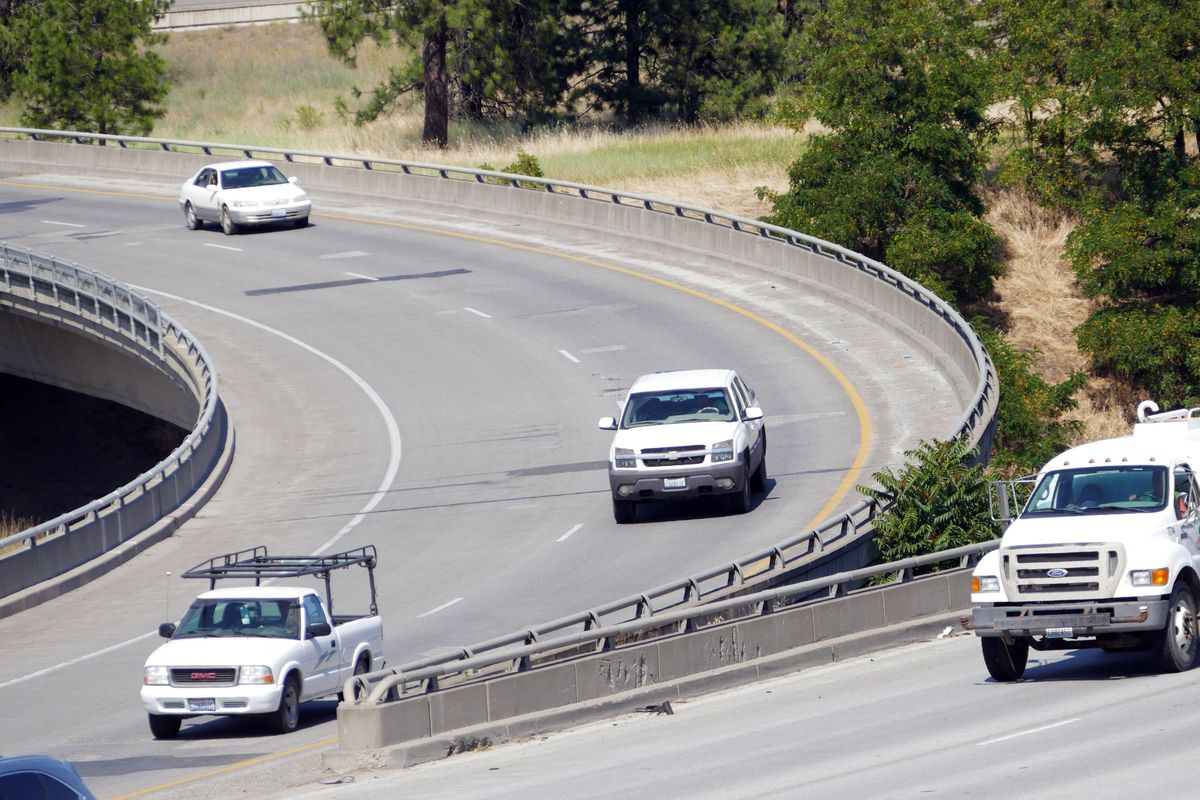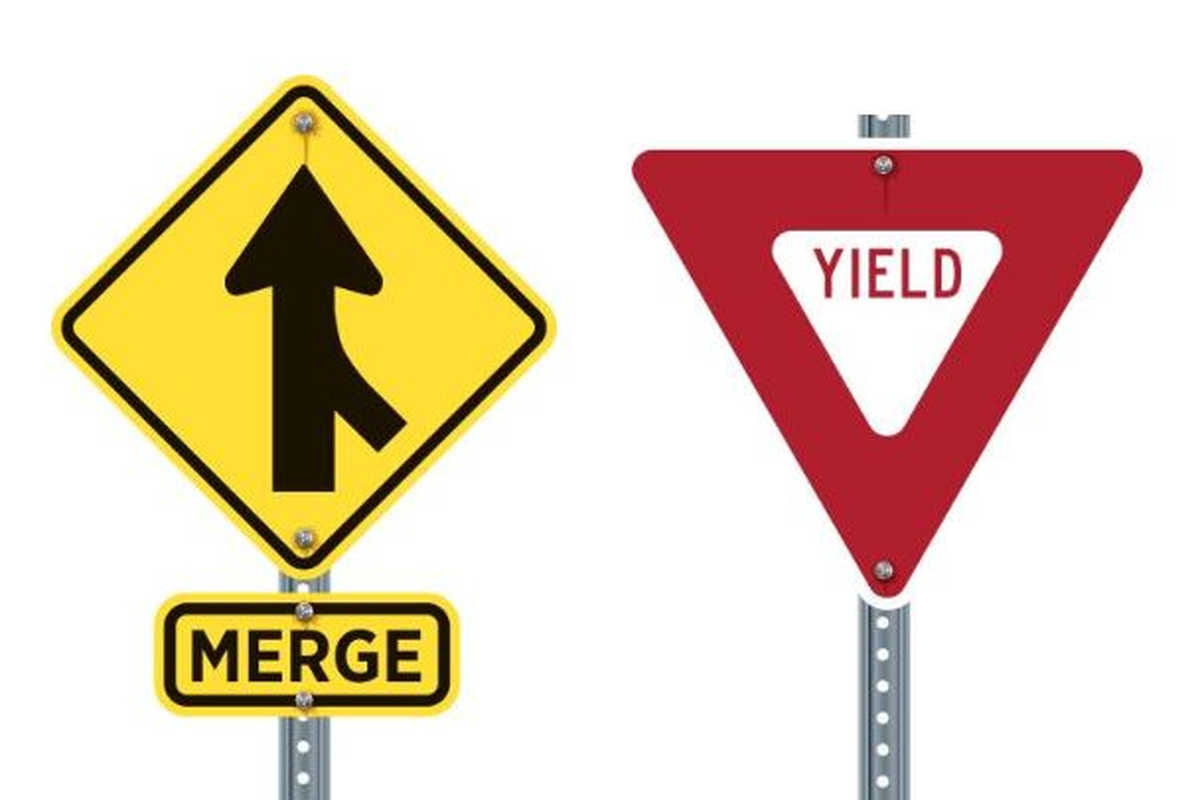Getting There: Yielding and merging onto freeway aren’t the same. (You should know with changes coming to I-90.)
The Hamilton Street on-ramp to Interstate 90. (Jesse Tinsley / The Spokesman-Review)Buy a print of this photo
Little-known fact: Those yield signs that motorists face when joining highway traffic, they mean yield.
As in, to relinquish, to give up, to surrender. You wouldn’t know it from some on-ramps, where drivers see that red-and-white triangular sign and barely look up from their smartphones, let alone apply the brakes. But when you enter a highway, you must submit to the traffic already flowing on that highway. It’s the law.
Like it or not, yield sign or no, the traffic you’re merging with has the right of way. As a matter of fact, state law starts with a stop sign.
“The operator of any vehicle entering upon any arterial highway from any other public highway or private way shall come to a complete stop before entering the arterial highway when stop signs are erected as provided by law,” says the Revised Code of Washington, otherwise known as the law.
But the law goes further, and states that a yield sign can only be erected after a traffic study finds that a stop sign is unnecessary.
Finally, to clear up any lingering doubts, the law does not mince words, but instead deploys Latin: “If such a driver is involved in a collision with a vehicle in the intersection or junction of roadways, after driving past a yield sign without stopping, such collision shall be deemed prima facie evidence of the driver’s failure to yield right-of-way.”
In other words, if you don’t yield when entering a highway, you’re to blame.
Motorists from California may be confused, and please accept our apologies. Here in Spokane, we recognize the debt we owe to Los Angeles and San Francisco. Denizens of those fine burgs dealt with gut-wrenching, maddening traffic decades before we did. They navigated the strange maze of Southern California highways, byways and freeways in the days before seat belts and air conditioning, when the radio dial only scoured the AM bandwidth. We’re just starting to experience traffic now, well into the 21st century.
In the Golden State, the rules are different. There, the people driving the 14.7 million vehicles registered with the state know that the law of their land is to merge. As in to combine, unite or coalesce.
Such unity of purpose would shock the drivers of Washington state, which has just a fifth the number of registered vehicles in California, with 2.9 million.
We yield, politely. They merge, presumptuously.
Not to throw cold water on this scorching hot California burn, but maybe we could learn something from the Californians. The original American drivers.
Just look at the interchange connecting U.S. Highway 195 to eastbound Interstate 90. One lane of traffic comes zooming in from the south to meet three lanes of transcontinental, Seattle-to-Boston traffic. Signs on I-90 politely ask motorists to move over, but they largely go unheeded. So what happens? A driver, following the law, stops on the on-ramp, waiting for a chance to join traffic. Behind them, the head of another motorist is cranked around to look at the onslaught of I-90, foot on the gas pedal.
Collision.
The interchange has become such a sore spot that state traffic engineers are building a ramp meter there. The alternating red and green light will portion out the traffic entering the interstate, providing timed intervals between vehicles, rather than allowing multiple vehicles to enter the freeway at once. According to the Washington State Department of Transportation, ramp meters reduce collisions by 30 percent, and this one is expected to be up and running next spring.
And that’s great and all, but what if we just got rid of the yield, and swapped in the merge? There’d still be collisions, sure, but wouldn’t more people move over if they knew they had to make way for merging traffic? What if we all had skin in the game, and neither the driver on the interstate nor the driver merging onto the interstate had the right of way? What if instead they just had to work it out?
Got a transportation question? Write to nickd@spokesman.com.
Amtrak gives veterans discount
This Veterans Day, go by rail. That’s the message from Amtrak, the nation’s passenger rail line, which is offering veterans 20 percent off tickets that are purchased through tomorrow.
The deal is good for travel through May 2019, and is valid for anywhere the train goes.
For more information, visit www.amtrak.com.
Stormwater traffic impacts
East- and westbound Trent Avenue in Spokane’s East Central Neighborhood will have lane restrictions between Byrd and Hough streets. The work is related to stormwater work and involves the installation of swales.
In Peaceful Valley, the work continues on Main Avenue. Last week, Cedar Street between Main and Wilson Avenue was paved. On Tuesday, Main east of Cedar will be paved.
A lane of Spokane Falls Boulevard in front of Spokane City Hall will be closed starting today through Thursday for utility and paving work.
Street leaf removal begins in Audubon
City crews will begin leaf pick-up today in the Audubon Neighborhood, beginning a citywide rotation to clear the streets of fall’s bounty. After Audubon, the city will move to Downriver, Northwest Boulevard and Cannon Hill.
The crews are driving rubber-bladed tractors that push leaves into a loader, which packs and prepares them to be hauled off. If weather allows, the crews will flush and sweep the streets. Crews may be out between 7 a.m. and 10 p.m. and leaf work will go until the snow falls.

